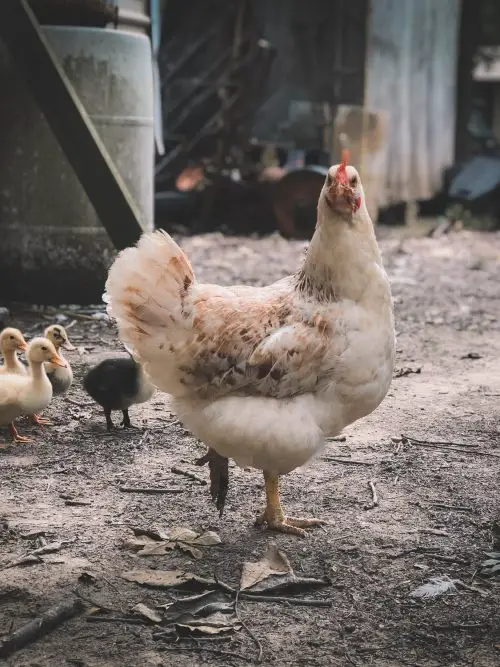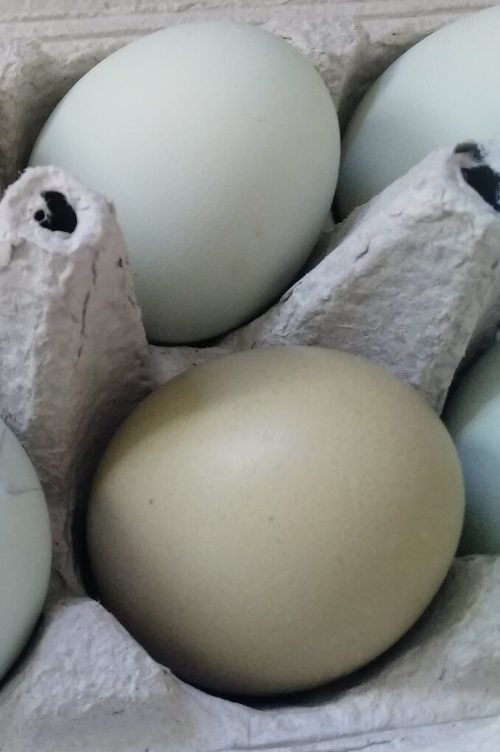Contrary to popular belief, the olive egger chicken (hen or rooster) is not actually a specific chicken breed. Even though you may have heard about Sapphire olive egger, which is one of its most famous varieties.
On this page, we are going to take an in-depth look at what this type of chicken is, and why you may want one. Bear with us. We are then going to round off with a few care tips!
What is an Olive Egger Chicken?
As we said before; an Olive egger chicken is not a specific breed. Instead, it is a combination of multiple breeds.
It doesn’t even matter what these breeds are, as long as they produce olive-colored eggs.
So, sapphire olive egger is just an olive egger with sapphire color.
To make an olive egger chicken, you would need the following:
- One chicken that lays dark brown eggs
- One chicken that lays blue eggs
It doesn’t matter what the breed is at all, as long as the chicken produces those colors of eggs. The result should be chicken that lays olive eggs.

If you don’t know what chickens lay blue eggs, then those are Ameraucana and Araucana chickens. Of course there are many more, Easter Egger is one of them for example, but they are not recognized by the American Poultry Association‘s standards.
Obviously, breeding doesn’t always pan out like that, but you should end up with reasonably olive egger eggs. It may swing more in one direction in certain cases.
Of course, you can’t control genes. Obviously, you can breed together two olive egger chickens to create more olive egger chickens. That isn’t an issue, and you will have more success if you go down that route.
Why isn’t the olive egger chicken recognized as a breed?
This is one of the most frequently asked questions. But, the answer is very simple. It is because an olive egger chicken is so called because it lays a different color of eggs to the norm. Since so many breeds can be combined to create an olive egger chicken, it can’t possibly be a specific breed and it will never be.
The only thing that links all of the chickens together is the fact that they lay olive eggs (a.k.a olive egger eggs). Nothing more than that!
Do You Want Big Beautiful Eggs?
Then you must check this ORGANIC & NON-GMO feed. Our hens lay jumbo eggs now and they love this feed! You can check it right here on Amazon.
Olive Egger Eggs
Some people love the look of the olive egger eggs in their basket. A lot of people enjoy these eggs when they are selling them too.
After all, they are eye-catching in the way that they look.
But honestly, there is no real reason as to why you should go out of your way to purchase an olive egger chicken.
They offer no specific benefits other than the fact that they lay olive colored eggs.

What Determines the Color of Olive Egger Eggs?
As we said before; you need a chicken that lays blue eggs and another chicken that lays dark brown eggs.
When a dark brown egg laying chicken lays an egg, it will lay an egg that has brown pigments on the outside. With a blue egg laying chicken, the entire shell will be blue. When it comes to an olive egger chicken, the darker the brown pigments, the darker and more pronounced the olive-colored egg will end up being.
So, if you want nice and dark olive-colored eggs, then you will want to choose a chicken that lays dark brown eggs to begin with. The darker, the better. It doesn’t matter the shade of blue, to be honest.
Sapphire Olive Egger Chicken
Since the olive egger chicken is formed of several different breeds, there is no ‘one-look’ for it. An olive egger chicken can look like just about any other chicken. The only time you will know that it is an olive egger is when it ends up laying that egg!
However, the most famous variety that you’ve probably met is the Sapphire Olive Egger. This is a hybrid breed.
There are so many different breeds that you can combine to make sapphire olive egger chicken.

For example, you can develop Sapphire olive egger by yourself by crossing Blue Plymouth Rock (also known as Sapphire Gem) and any Easter Egger.
Remember, as we said before, there are only two recognized breeds (Ameraucana and Araucana), however, the term ‘Easter egger‘ refers to any chicken that lay blue eggs, not only these two.
With that being said, we can’t tell you information about the size of egg the Sapphire olive eggers are going to be producing, as well as the number of eggs they produce per year.
However, on average, you will find that most olive egger chicken breeds will produce up to 200 eggs per year, although this can be boosted a little bit by changing the breed combination. However, in our research, you are probably going to struggle to get more than 200 from any sapphire olive egger, unless you are very lucky!
The Olive Egger Chicken Personality and Temperament
This is something that is pretty difficult to determine. The personality of the olive egger is going to be based upon the personality of the breeds that have gone into producing that chicken.
Therefore, you will need to look at a breed profile for the two chicken breeds before you determine whether a specific olive egger chicken is the right choice for you.
That being said, the vast majority of chickens that make up the olive egger are fairly calm breeds. This means that you probably will not end up with any issues with your olive egger chickens, no matter what combination of breeds has gone into making them.
However, as we said, you do still need to do your research. After all, you need to know how to behave around your chicken, how well they socialize with other breeds of chicken and, perhaps more importantly, whether they love to fly off.
Olive Egger Chicken Care Tips
Honestly, looking after an olive egger chicken is no different from looking after a standard chicken. This means that you are going to need to give them a good diet. As with all other chickens, the bulk of their diet should come from the specific chicken feed that you give them.
They will also need a bit of chicken grit handy. Every now and then, you can tempt them with some meaty protein, vegetables, and fruits. However, in no circumstances should those ever be a staple part of a chicken’s diet, olive egger or not.
If you do, then we can virtually guarantee that your chicken egg production will slow down, and you will barely have any awesome olive-colored eggs to enjoy!
Olive Egger Chicks for Sale
A lot of people will breed olive eggers themselves, simply because it is not a difficult thing to do. However, if you really do not fancy going through the whole rigmarole of breeding your own chickens, then you will find plenty of chicken breeders that offer olive egger chicks for sale or even сapphire оlive еgger.
Just make sure that you purchase from a reputable breeder.
Here are some reputable hatcheries that you may consider (they ship nationwide), where you can find olive egger or sapphire olive egger chicks for sale:
The general cost per chick ranges from $2.50-$5 for males and $3.50-$7 for females. Straight run chicks usually range less.
If you are new to backyard chickens and wondering why straight run chicks are chipper, it is simply because no chick-sexing has taken place with these chicks. It means you may end up with 10 rooster if you buy 10 straight run chicks. You never know.
- What Are Olive Egger Chickens? Olive Egger chickens are hybrids specifically bred to produce eggs with unique and captivating green, olive, or khaki-colored shells. They’re not a standardized breed themselves but rather a product of strategic crossbreeding.
- How Are Olive Eggers Created? The creation of Olive Eggers involves selecting a dark brown egg-laying breed, often Marans, and pairing it with a blue egg-laying breed like Ameraucana or Araucana. The blending of these eggshell color genes results in the distinct green tones.
- Understanding Egg Color Variation: One of the intriguing aspects of Olive Eggers is the wide range of eggshell colors they can lay. The shade of green or olive can differ not only between individual hens but also throughout different egg-laying cycles.
- Recognition and Hybrid Nature: Olive Eggers aren’t recognized as standalone breeds by poultry associations due to their hybrid status. They’re a testament to the creative breeding efforts to achieve aesthetic and unique egg colors.
- Temperament and Personality: Olive Eggers typically inherit friendly and approachable temperaments from their parent breeds. This disposition makes them excellent candidates for family-friendly flocks and interactions with children.
- Distinctive Appearance: While Olive Eggers’ primary allure is their eggshell color, their physical characteristics can vary widely. Their appearances might showcase the features of their parent breeds, creating a delightful blend of traits.
- Comparing Egg Production: Olive Eggers, while prized for their egg color, can also be competent layers. However, egg production varies based on the genetic traits inherited from the parent breeds. Some may excel as layers, while others might focus on their eggshell coloration.
- Breeding Considerations: Breeding Olive Eggers can be both an educational and rewarding endeavor. However, understanding the genetics behind eggshell color inheritance is crucial to achieve the desired shades in subsequent generations.
- Standard Care and Maintenance: Olive Eggers require the same level of care and attention as other chicken breeds. Providing them with proper nutrition, suitable housing, access to clean water, and regular health checks ensures their well-being.
- Versatility for Meat Purposes: While Olive Eggers are primarily sought for their unique eggshell color, they can serve as dual-purpose birds for meat production, depending on the parent breeds involved in the cross.


